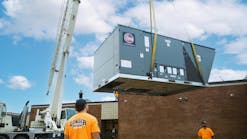What does the energy business in the twenty-first century have to do with that business fifty years ago? Well, here is a quick history lesson. Performance contracting as a method for implementing energy projects originated in Europe after World War II and was called "chauffage," or "heat" in French. The concept was necessitated by two critical needs: the need to rebuild and renew capital infrastructure that was ravaged during the war years, and the need to control astronomical energy costs for building owners. Chauffage was a solution that provided building owners with engineering, facility management and financing. The concept came to the U.S. in the early 1980s as "shared savings" and rapidly developed into a new business model referred to as performance contracting or energy services.
This is usually where a story reads, "And the rest is history." However, that's not the case for performance contracting. It's the present and the future. In fact, it's experiencing continual evolution and is poised to enter a new frontier.
With performance contracting, the ultimate technology limiters have to do with energy cost and the enabling legislation in a particular state. (Readers who want to learn more about enabling legislation in specific states may start by visiting www.dsireusa.org and clicking on the states of interest.) Critical aspects of the legislation, such as the term that's enabled for such agreements and the types of technology that are allowed, will define the technologies that can be implemented. By the same token, the local cost of energy (particularly electricity), and the presence of utility rebates are also factors.
Historic Power Outage Sends a Jolt
"Energy reliability" is also critical to building owners. This has also become a factor in performance contracting. It was actually the electric blackout of 2003 that acted as the catalyst to start the Smart Grid movement and precipitated the rebirth of energy rebates, which can add an additional source of money to drive technology solutions as part of a performance contract.
Given this background, what makes up today's state of the art technology solutions in performance contracts? That's a hard target to hit, as energy conservation measures (ECMs) and the technology behind them are growing by leaps and bounds. ECM’s typically include a wide range of technology measure that pay for themselves through savings from lighting to high efficiency HVAC. But there are also some clear new trends.
Trends to Watch
For example, detailed "energy dashboards" are taking the place of simple power monitors. These dashboards are how you represent information and present it to the customer.
Starting the mid-to late-1980s and going into the 2000s, a hot topic was building automation systems that had graphic interfaces. As building automation systems became more popular, these interfaces grew to incorporate work order systems to track preventive maintenance needs, as well as energy usage. Integration of building automation systems started occurring on a very fast pace, and everyone began migrating towards the idea of having a web-based unified front end. This technology is a common ECM.
Today, web-based dashboards represent the newest evolution of these interfaces. There are almost as many vendors selling software interfaces as there are vendors selling building automation systems.
One of the hottest topics coming down the pike over the next three to five years will be analytics. Analytics cover how we instrument a building so we can truly measure its energy consumption and performance, develop performance metrics, and so forth. In many cases, analytics are installed in a building as part of an energy services project.
Ultimately, energy dashboards and analytics will merge and migrate to the point where we’ll be providing software tools to analyze the technology that we've implemented as part of an energy service project. These tools provide customers with a tremendous amount of ongoing information about their building's performance.
Traditionally there was a legal requirement that an energy services company (ESCO) had to provide measurement and verification on the savings its energy conservation measures were achieving. This was typically done once a year: the ESCO would sit down with a customer and say, "Here's the baseline we started with, here's what we said you would save each year, and here is an analysis of your utility bills for the past year." This annual assessment would include adjustments for any changes in scope that occurred during the year, such as the customer adding more square footage to the building or changing the building’s usage patterns.
Energy dashboards, however, will provide customers with fresh analytics on demand. These up-to-the-minute analytics will help customers understand if they're on track (or not) for their projected energy savings. Think about it from the customer's point of view: they are making payments to a bank or other entity that financed their ability to invest in energy conservation measures and enter into a performance contract. Customers are thinking, "I'm going to make that payment whether I'm saving or not. So if I'm not saving — or perhaps saving even more than was projected — I'd rather know sooner rather than waiting until the end of the year."
Every Building a 'Power Plant'
The other important aspect of performance contracting is what information is presented to your customers. The discussion of dashboards and measurement and verification were very much about metering, but the real notion here is that the building can also become a virtual power plant. This means the building can modify its energy consumption, but also can become a net electricity producer. Combing on site generation with technology to proactively manage the building energy profile are key characteristics of a microgrid.
Microgrids, demand response, and metering may seem like they're outside the bounds of HVAC, but really it's just an offshoot of what we used to call combined heat and power. There's a huge HVAC element in it. For example, in 2009 we worked on an energy management project that earned a Design/Build award from Contracting Business.com magazine. In that project, we used a solar thermal system to run an absorption chiller and to charge thermal storage so that when we were calculating the value proposition for financing, we were able to look at a component of savings that was coming from reducing electric use at times of peak demand. (Find the story at Smart People, Smart Grid)
In that project, some of the metering was electrical, but there was also a great deal of BTUH metering at the air handler level, flow metering for the chilled water loop and the hot water campus loop, and so forth. These things are clearly within the scope of HVAC contractors, as are geothermal, photovoltaics, and other complex systems that require very high quality installations. In fact, these are the very things you can use to differentiate yourself. The customer who says, "You did this great job on this geothermal system; who do you recommend to do the photovoltaics?" will be happy to hear you say, "We can do that."
Build That Bundle
Add more services, generate more revenue, and maintain that customer relationship. Selling more to current customers is always a faster way to grow your business than adding new customers. Of course, perhaps as an HVAC contractor you don’t want to develop the bonding capacity and all the internal capabilities necessary to do an energy services contract. If that's the case, consider developing or joining a team that can do so. Partner with quality general contractors, electrical contractors, energy services contractors, and banks, and work with them on an ongoing basis so you can offer your customers exactly what they want and need.
What's at stake? I'll share a quote I heard recently during a meeting last year with Southern California Edison. Their personnel said, "We believe we've given out our last lighting rebate. We believe our last customer who was going to do a retrofit of their lights because there was a rebate has done it. We think the next frontier for rebates is HVAC controls and building automation, and that's where we’re going to spend our money."
The energy efficient technology and financing are in place for a major resurgence of building automation and HVAC optimization. Be ready to identify and pursue opportunities that exist in your community.
Jack McGowan is president of Energy Control Inc, an OpTerra Energy Company, an energy services company based in Albuquerque, NM. He is also Chairman Emeritus, DOE GridWise Architecture Council. He can be reached at 505/263-7930, or by e-mail at [email protected].








